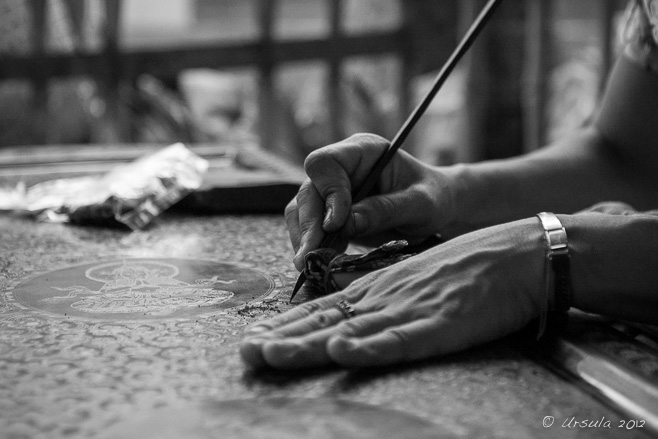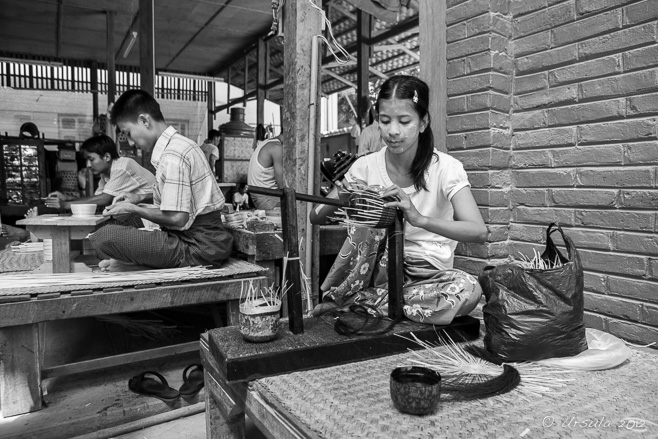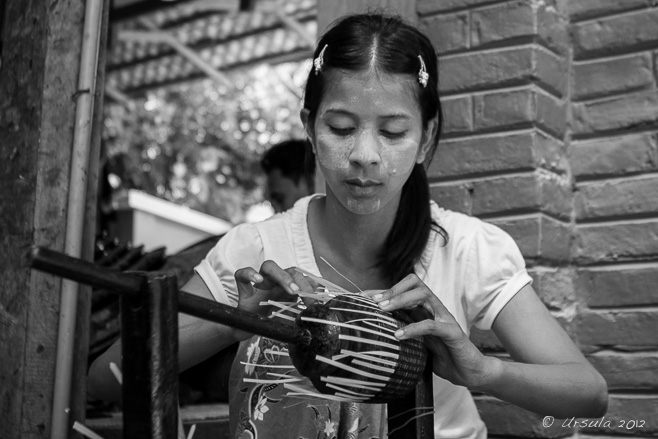
Etching Details
Making fine Burmese lacquerware is time-consuming and labour-intensive.
There is something universal about the search for beauty.
We may not agree on what “beauty” is – indeed, Western philosophy has argued conceptions of beauty extensively over time – but we all seek to surround ourselves with objects that are not merely functional, but are also aesthetically pleasing.
One of the many joys of travel, for me, is seeing how “other people” do things – especially in terms of creating functional objects in beautiful forms. From clothing to architecture, people seem driven to decorate themselves and their environments in ways that are culturally and regionally distinctive.
Take Burmese lacquerware for example: it takes time, skill, a steady hand, and an eye for design to transform simple wood or metal surfaces into richly decorated objects.
For centuries, people in Asia have used lacquer made from the resin of the “Japanese varnish tree” or the “Chinese lacquer tree” (Toxicodendron vernicifluum) to give wooden products a tough, durable and water-resistant finish. A simple red lacquered wooden bowl thought to date to the 5th millennium BC was found in Zhejiang, China. Much later, during the Shang Dynasty (ca. 1600–1046 BC) in China, sophisticated lacquer techniques were developed and it became a highly artistic craft.
The Burmese style of making lacquerware, called Yun-de, was introduced into the country by Yun or Laos Shan artisans from the north of Thailand in the mid-1500s. The lacquer, which comes from the sap of the “Burmese lacquer tree” or “Thitsee” (Melanorrhoea usitata), starts out straw-coloured, but turns black when exposed to air. Many layers of lacquer are applied to a bamboo form, each needing to dry for several days before being polished to a smooth finish, engraved with intricate designs, and painted.
“The best lacquerware in [the] world is crafted in Bagan, Myanmar, a village steeped in two hundred years of practice in the craft.” When I visited the U Ba Nyein Lacquerware Workshop in Bagan, I was able to watch some of the steps in the manufacture process.
On a photographic note: I don’t usually opt for black and white, but my original shots were “noisy” with colour, which I thought distracted from the sense of quiet concentration I felt emanating from the workers. Working in black and white also gave me a chance to experiment with different editing processes.

Weaving the Base
A base for the lacquer coating is made of bamboo strips woven together with horsehair.

Weaving Bamboo
The combination of bamboo and horsehair gives the material strength and flexibility.

Bamboo Pots
The bamboo form is built up in layers.

Chiselling the Base
Bamboo bases are chiselled into the desired form.

Applying Thayo
Thayo, a thick mixture of thitsee resin with ash or sawdust, is layered onto the bamboo forms. Subsequent layers of resin might be thinner.

Pressing and Polishing
Thayo, the thitsee tree resin mixture, can be sculpted while wet.

Engraving Details
Once the many layers of lacquer are dry and polished, detailed patterns can be etched into it.

Etching Lacquerware
All the designs and engraving are done free-hand…

Etching Lacquerware
… taking steady hands …

Etching Lacquerware
… and a great deal of concentration.

Painting Lacquerware
Elaborate designs commonly use red, green and yellow colours – or even gold leaf.

Painting Lacquerware
Large pieces can take a year to complete.

Washing Lacquerware
Even small pieces can take months.

Lacquerware Pots
As well as intricate patterns, designs include pictorial scenes from popular stories, and signs of the Burmese zodiac.

Final Wash and Polish

Sorting Pots and Lids

Wall Display
A range of items are on show in the display area, including hsun, rice bowls with stems and spired lids.

Vases and Table-Ware

Home Decor
The advent of plastics, porcelain and metal for use in everyday utensils have greatly reduced the need for lacquerware, and today it is predominantly produced for decorative items and for tourists.
However, while the opening-up of Myanmar has meant more international tourism, it has put whole new pressures on the job market, with young people preferring work in the hospitality sector.
In a recent (February, 2014) news story, Ma Mee Mee, co-owner of the U Ba Nyein Lacquerware Workshop, said: “We are worried that Bagan will lose the battle to save our traditional lacquerware culture.”
 That would, indeed, be a great shame.
That would, indeed, be a great shame.
I did my bit, and came home with a small piece of beautifully crafted artwork.
Until next time ~ Happy Shopping!
Pictures: 18September2012
























.png)


This makes me really feel like visiting the place.
Thank you.
Thanks, Pongpet! It is a special place.:D
[…] Etching Lacquerware Our next stop was at a handicraft workshop, where high quality lacquerware is still produced in the traditional manner. (See the Blog Post: Etching U Ba Nyein Lacquerware) […]
I’m inpressed.Can i get ur mobile number or office phone number for my business?
Thanks for your visit!
As you can see from the Blog, this business is not mine – but their information is on their website. 😀